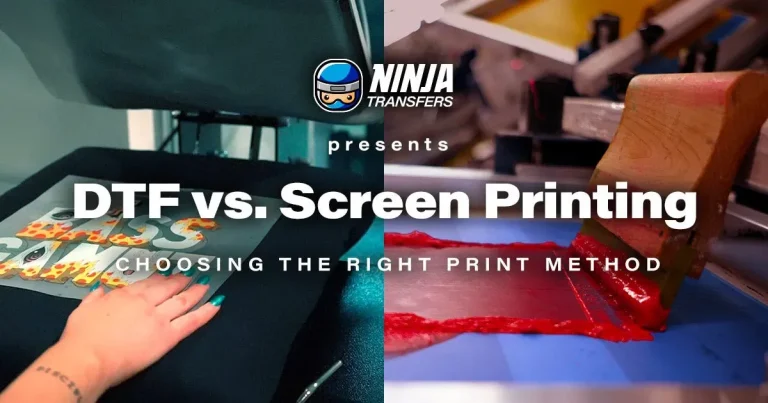When exploring the world of custom apparel, the debate between **DTF transfers vs. screen printing** quickly emerges as a pivotal consideration. Both methodologies present their own distinct advantages that cater to various printing needs, making them popular choices among designers and businesses alike. Understanding the nuances of each technique can greatly influence the final output, be it in terms of print quality or overall cost-effectiveness. This introductory guide will delve into the key features of Direct-to-Film Printing and screen printing, shining a light on their unique characteristics. By doing so, we aim to equip you with the knowledge to make an informed choice tailored to your specific project requirements.
In the realm of custom apparel printing, discerning the right printing technique can be daunting, especially with options like **Direct-to-Film (DTF) printing** and traditional screen printing. Each method brings its own set of strengths, appealing to different project sizes, design complexities, and budget constraints. Screen printing, a classic choice, is celebrated for its durability and vivid color outputs, while DTF printing is rapidly gaining recognition for its detailed image reproduction and efficiency. This article aims to compare these two popular methods, focusing on print quality, setup costs, and their respective advantages. By understanding the essential differences, you can make an educated decision that aligns with your unique printing needs.
Key Differences Between DTF Transfers and Screen Printing
Understanding the key differences between **DTF transfers** and screen printing is essential for anyone looking to customize apparel. DTF transfers utilize a method where an image is printed directly onto a film and then transferred onto fabric using a heat press. This allows for intricate designs with vibrant colors and fine detail. On the other hand, screen printing involves creating stencils for each color in the design, which can increase setup time and costs but results in durable and vibrant prints. Knowing these fundamental differences can guide your choice based on your specific customization needs.
In terms of versatility, DTF transfers excel particularly for jobs requiring a wide color gamut and detailed graphics. The process accommodates graphics with color blends and gradients that would be difficult to achieve with the traditional screen printing method. Conversely, while screen printing provides a robust and long-lasting solution, it may struggle with the same complexity when it comes to more intricate designs, making it necessary to evaluate your design requirements upfront.
Frequently Asked Questions
What are the main differences between DTF transfers and screen printing?
When comparing DTF transfers vs screen printing, the primary differences lie in setup, color vibrancy, and production scale. DTF transfers excel in detailed, full-color designs and lower setup costs for small runs, while screen printing is ideal for bulk orders and offers vibrant, durable prints. Each method has unique advantages depending on your project needs.
Are DTF transfers better for small custom apparel projects than screen printing?
Yes, DTF transfers are often better suited for small custom apparel projects compared to screen printing. This is because DTF printing does not require extensive setup costs for individual designs, making it more economical for low-volume orders while still achieving high-quality prints.
What are the screen printing advantages compared to DTF transfer printing?
Screen printing advantages include vibrant color application, durability of prints, and cost-effectiveness for large orders. Unlike DTF transfers, screen printing inks penetrate the fabric, creating long-lasting designs that withstand frequent washing, making it an excellent choice for bulk custom apparel.
How does print quality compare between DTF transfers and screen printing?
In the print quality comparison of DTF transfers vs screen printing, both methods can produce excellent results. However, DTF transfers provide superior detail and color range, making them ideal for intricate designs, whereas screen printing offers strong, opaque colors that last longer, especially on darker fabrics.
What are the DTF transfer advantages in custom apparel printing?
DTF transfer advantages for custom apparel printing include exceptional detail reproduction, quick turnaround times, and flexibility in design application. This method allows for vibrant prints without requiring the initial investment of screens, making it perfect for unique or short-run designs.
Which printing method is more environmentally friendly: DTF transfers or screen printing?
Screen printing is often considered more environmentally friendly due to its use of water-based inks, which are less harmful than solvent-based options. However, DTF printing is evolving with advancements toward eco-friendly inks, making it a greener choice as technology improves.
| Aspect | DTF Transfers | Screen Printing |
|---|---|---|
| Detail and Color Range | Incredible detail with a wide color gamut, ideal for designs with gradients and photographic images. | Produces vibrant colors but limited with intricate designs and gradients due to stencil creation. |
| Setup Costs | Lower setup costs, more economical for small orders as no screens are required. | Higher setup costs due to screen preparation, more economical for larger bulk orders. |
| Durability | Durable when properly applied but may not last as long as screen prints under heavy washing. | Long-lasting prints, ideal for regular wear and washing due to deep ink absorption into fabric. |
| Production Speed | Rapid production times with modern printers, suitable for quick turnarounds. | Longer setup times as screens are required for each color layer, affecting overall speed. |
| Sustainability | Moving towards eco-friendly inks with reduced waste. | Uses water-based inks, considered more environmentally friendly than solvent-based options. |
Summary
DTF transfers vs screen printing is a crucial discussion for anyone looking to customize apparel effectively. While DTF transfers offer impressive detail and lower initial costs for smaller batches, screen printing excels in durability and vibrancy for larger orders. Evaluating your project specifications, such as the design’s complexity and the quantity needed, will ultimately guide your selection of the most suitable printing method. Whichever method you choose, informed decisions will lead to better outcomes in your custom apparel endeavors.

